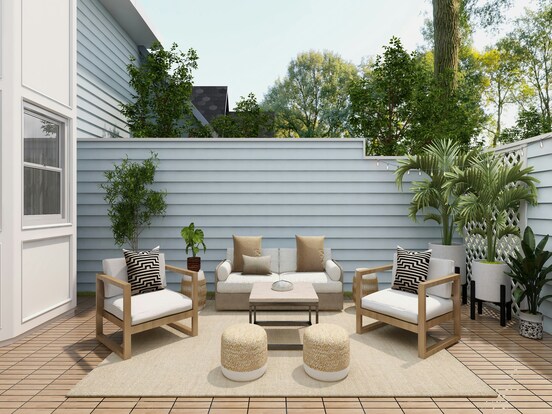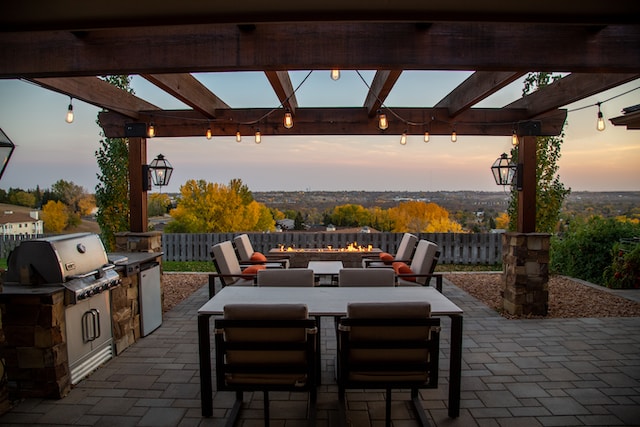Imagine hosting a barbecue party in your backyard, effortlessly preparing gourmet meals while enjoying the company of your friends and family. Outdoor kitchens have seen a surge in popularity and for a good reason. They offer homeowners an exciting and practical way to elevate their outdoor living spaces.
In this blog post, we will explore the ins and outs of designing an outdoor kitchen, providing you with valuable insights, practical tips, and plenty of examples to spark your creativity. From planning and budgeting to selecting materials and maintaining your setup, you’ll find everything you need to create the perfect outdoor cooking oasis.

Planning Your Outdoor Kitchen
Factors to Consider
Before you jump into designing your outdoor kitchen, it’s essential to consider several factors. First, assess the available space in your backyard. You’ll need enough room for appliances, countertops, and seating areas without overcrowding the space. Measure carefully and create a layout that allows for comfortable movement and a logical flow.
Next, establish a budget for your project. Outdoor kitchens can range from modest setups to luxurious extravaganzas, so it’s crucial to determine how much you’re willing to spend. Be sure to account for all expenses, including materials, labor, and additional features.
Climate is another critical factor. Consider how weather conditions in your area might impact your outdoor kitchen. If you live in a region with harsh winters or frequent rain, you’ll need durable materials and possibly some form of shelter to protect your investment.
Functionality and Aesthetics
When planning your outdoor kitchen, it’s essential to strike a balance between functionality and aesthetics. Think about how you’ll use the space and what features are most important to you. For example, if you love grilling, prioritise a high-quality barbecue. If you enjoy hosting dinner parties, ensure there’s ample seating and counter space for food preparation and serving.
Aesthetics play a vital role in creating an inviting atmosphere. Choose a design that complements your home’s architecture and landscaping. Consider using natural materials like stone or wood to blend seamlessly with the outdoor environment. Incorporate elements such as plants, decorative lighting, and comfortable furniture to enhance the overall appeal.
Key Design Elements
Selection of Appliances
Choosing the right appliances for your outdoor kitchen is crucial. Focus on durable, weather-resistant options specifically designed for outdoor use. Key appliances to consider include:
- Grills: The heart of any outdoor kitchen, opt for a high-quality gas or charcoal grill.
- Refrigerators: Keep beverages and perishable items cool with an outdoor-rated fridge.
- Sinks: A sink with running water adds convenience and makes cleanup easier.
- Pizza Ovens: For those who love homemade pizza, a wood-fired or gas pizza oven is a fantastic addition.
Materials for Countertops, Flooring, and Cabinets
Selecting the right materials ensures your outdoor kitchen remains functional and visually appealing. For countertops, choose durable options like granite, stainless steel, or concrete. These materials can withstand the elements and are easy to clean.
When it comes to flooring, opt for slip-resistant surfaces like natural stone, textured concrete, or outdoor-rated tile. These materials provide a safe and stylish foundation for your outdoor kitchen.
Cabinets should be made from weather-resistant materials such as marine-grade polymer, stainless steel, or teak. These options offer durability and require minimal maintenance, ensuring your kitchen remains in top condition.
The Role of Lighting and Ventilation
Proper lighting and ventilation are essential components of a well-designed outdoor kitchen. Install task lighting above cooking and preparation areas to ensure visibility during evening gatherings. Ambient lighting, such as string lights or lanterns, creates a warm and inviting atmosphere.
Ventilation is equally important, especially if your outdoor kitchen is covered or enclosed. Proper ventilation helps disperse smoke and cooking odors, ensuring a pleasant environment for you and your guests. Consider installing a vent hood above your grill or incorporating strategically placed vents to promote airflow.
DIY vs. Hiring a Professional
Pros and Cons of Each Approach
When embarking on an outdoor kitchen project, you may wonder whether to tackle it yourself or hire a professional. Both approaches have their advantages and disadvantages.
DIY projects can be cost-effective and allow for a more personalised touch. You have complete control over the design and can work at your own pace. However, DIY projects require a significant time investment and a certain level of expertise. Mistakes can be costly and may result in a less-than-perfect outcome.
Hiring a professional offers peace of mind, as experienced contractors bring knowledge and skills to the table. They can handle complex tasks and ensure your outdoor kitchen meets safety codes and regulations. The downside is that professional services come at a higher cost and may limit your involvement in the design process.
How to Decide
To determine which option is best for your project, assess your skills, budget, and available time. If you have experience with home improvement projects and enjoy hands-on work, a DIY approach might be suitable. On the other hand, if you lack the necessary skills or prefer a hassle-free experience, hiring a professional is likely the better choice.
Budgeting and Cost Control
Setting a Realistic Budget
Establishing a realistic budget is a crucial step in designing your outdoor kitchen. Start by listing all potential expenses, including appliances, materials, labor, and permits. Research the cost of each item and factor in any additional features you desire, such as a pergola or outdoor seating.
Cost-Saving Strategies
1. Prioritise Essentials – Focus on essential elements first, such as the grill, countertops, and seating. Add luxury items like outdoor pizza ovens or specialty lighting later as your budget allows.
2. Shop Smart – Look for sales, discounts, and second-hand options for appliances and materials. Purchasing during off-season periods can also save you money.
3. DIY When Possible – Consider handling some aspects of the project yourself, like painting or assembling furniture. This can reduce labor costs and keep your budget in check.
By following these cost-saving strategies, you can create a stunning outdoor kitchen without breaking the bank.
 Building and Installation Process
Building and Installation Process
Step-by-Step Guide
Building an outdoor kitchen involves several steps, each requiring careful planning and execution. Here’s a general overview of the process:
- Design and Layout – Create a detailed plan, including measurements, appliance placement, and seating arrangements.
- Site Preparation – Clear the area, level the ground, and install necessary utilities such as gas, water, and electricity.
- Construction – Build the foundation, install countertops, cabinets, and appliances. Ensure proper ventilation and lighting.
- Finishing Touches – Add decorative elements, seating, and any additional features to complete your outdoor kitchen.
Common Challenges
During the building process, you may encounter challenges such as permitting issues, supply delays, or unexpected costs. To overcome these obstacles, maintain open communication with your contractor (if hiring) and have a contingency plan in place. Flexibility and patience are key to successfully completing your project.
Maintenance and Longevity
Best Practices for Maintenance
Regular maintenance is essential to keep your outdoor kitchen in top condition. Clean appliances and surfaces after each use, and periodically inspect for signs of wear or damage. Use appropriate cleaning products to avoid damaging materials.
Protecting Your Investment
Invest in weatherproof covers for your appliances and furniture to protect them from the elements. Consider adding a pergola or awning to provide additional shelter. During harsh weather conditions, move portable items indoors to prevent damage.
By following these maintenance practices, you can extend the lifespan of your outdoor kitchen and enjoy it for years to come.
Conclusion
Designing an outdoor kitchen is a rewarding project that enhances your home’s value and provides a unique space for entertaining and relaxation. From planning and budgeting to selecting materials and maintaining your setup, this guide has covered all the essential steps to help you create the perfect outdoor cooking oasis.
We encourage you to share your experiences and ask questions in the comments below. If you’re ready to take the next step, explore our range of related products and expert services to bring your outdoor kitchen vision to life. Happy cooking!


 Building and Installation Process
Building and Installation Process

